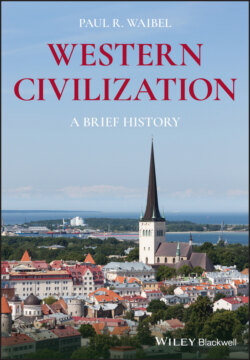Читать книгу Western Civilization - Paul R. Waibel - Страница 8
Preface
ОглавлениеI began teaching survey courses in the history of Western Civilization in 1975 as a graduate teaching assistant at West Virginia University. From then until my retirement from teaching in 2016, I taught survey courses in Western Civilization and World Civilization, as well as upper level courses in everything from ancient history to the history of the twentieth century. During my 40 years of teaching at four colleges and universities, I watched higher education in the United States undergo radical change. Today's students represent a wide range of academic preparation.
The growth of what is commonly referred to as “non‐traditional” education has required a rethinking of how core courses are taught and what can be required from the students enrolled in them. Such courses are often marketed as a means for working adults to complete a degree once started, but interrupted. Frequently, adult students need to take a semester or two of history survey to meet a core requirement. Hence, courses in Western Civilization or World History are offered. Students may be required to attend evening classes that meet once a week for six to eight weeks, during which an entire semester's work is completed. At one point in my career, I was assigned to teach a one‐semester course in Western Civilization in a weeks as part of a non‐traditional adult program. Increasingly, non‐traditional courses are taught online, either live or prerecorded. Adult students taking these condensed courses, while at the same time trying to juggle work, family, and other of life's daily demands usually have very little time to spend reading the traditional survey history textbook.
Taking all of the above into consideration, I set for myself the task of writing a Western Civilization text that could be used in the traditional on‐campus course, or the non‐traditional classes. I wanted the text to be written in an interesting and engaging style, that is to say, I wanted it to be more than a chronological list of dates and names of dead people. What Theodore Roosevelt said of writing in general, I think is especially important in writing a history text for today's student population: “Writings are useless, unless they are read, and they cannot be read unless they are readable.” A history text should not be a dry academic piling up of facts. Historian Barbara W. Tuchman described herself “as a storyteller, a narrator, who deals in true stories, not fiction.” She also noted that writing readable history is not easy: “One has to sit down on that chair and think and transform thought into readable, conservative, interesting sentences that both make sense and make the reader turn the page.”
When writing this and earlier books, I tried, however imperfectly to follow Ms. Tuchman's advice and example. With that in mind, I chose to emphasize topics that students I taught over the many past years found interesting and likely to stimulate class discussion. I am well aware that there is no such thing as true objectivity in teaching or writing history. Merely selecting what historical events and personalities to include in a brief history destroys any such pretense. E.H. Carr called attention to this handicap of every historian in his classic What is History? “The belief in a hard core of historical facts existing independently of the historian,” wrote Carr, “is a preposterous fallacy, but one that is very hard to eradicate.”
Being aware that my own understanding and interpretation of historical events will invariably find its way into my writing to some degree, I nevertheless tried to be faithful to the facts. However, I do have a theme, or organizing idea, around which my story of the rise of Western Civilization is constructed, and it is a rather traditional one.
The roots of Western Civilization are found in the Ancient Near East and the Greco‐Roman world. From the former came the Judeo‐Christian religious tradition. From the latter came classical humanism. These two different ways of understanding the universe – how it works, whether it has meaning, humankind's place in it, etc. – was synthesized with certain Germanic traditions during the period of the Middle Ages in Europe. By AD 1000, there was in Europe, a new civilization that was different from all others, and armed with a worldview that facilitated both a Scientific Revolution and an Industrial Revolution. With a virtual monopoly on useful (that is, scientific) knowledge, Western Civilization was able to dominate the world by the end of the nineteenth century.
The spread of Western Civilization to the non‐Western world enabled those previously more advanced civilizations to “modernize,” and liberate themselves from Western imperialism. By the beginning of the twenty‐first century, a modernized China, for example, was able to challenge the West for world leadership. Still, the world we live in is a Westernized world.
